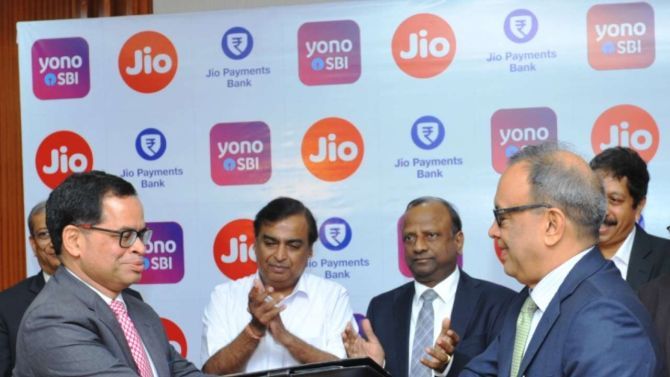India's huge digital prowess and potential will play a huge role in enabling digital lending, says Romita Majumdar.

Reliance Jio’s recent partnership with SBI’s digital platform to offer a shared ecosystem of services to customers, is just another example of how companies with a huge digital reach and technology base are tapping financial services to offer consumers all services on a platter with finance being the last step.
This also means that large recognisable brands are foraying into the space by introducing their own finance and payments arms and offering lending services.
This, on the other hand, is also helping them contain the consumers in their respective platforms whether it is e-commerce, telecommunication, retail or even automotive.
“Given the low penetration of credit in India, lending is an attractive business opportunity.
"We believe that non-traditional companies that have a strong brand, large consumer base as well as a strong distribution network will attack the lending market through innovative digital models,” said Alpesh Shah, a senior partner with Boston Consulting Group (BCG), who co-authored a recent report on digital lending.
The report had projected that digital lending will become a $1 trillion (approx Rs 68 trillion) opportunity in India over the next five years and be driven by these new age platforms.
The fact that the government has taken an initiative in regulating the sector and has stepped in to provide the digital framework through the India Stack (Aadhar, eKYC, UPI, Digilocker and eSign services) has in fact democratised the lending sector allowing multiple players with diverse offerings to compete on the same platform as financial giants, noted Shah.
This year, mobile manufacturer Xiaomi introduced Mi Credit in partnership with personal loan platform KreditBee which in turn utilises the eKYC verification to generate instant loans of up to Rs 100,000.
Xiaomi added this to the portfolio in addition to their over the top (OTT) music and video streaming services.
Similarly, e-commerce giant Flipkart is awaiting its NBFC licence which will allow the company to extend similar services to its 100 million consumer base as well as sellers, especially because no retailer wants to lose customers at the last mile to “insufficient balance” concerns.
Similarly, Cox & Kings Financial Service, a wholly owned subsidiary of travel firm Cox & Kings, was recently granted NBFC licence.
The company proposes to carry out the business of holiday financing, student loan financing and other non-banking financial service activities and a foreign exchange business.
“Transaction-led banking will become a potential use case for banks and corporates, both of which face issues in dealing with the MSMEs that seek funds or are a part of the supply chain.
"Digital funding access will enable corporates to drive consumer uptake and at the same time enable millions of young consumers to enjoy credit facilities for their lifestyle, which they can’t afford immediately,” said Manish Lunia, co-founder of Flexiloans.com.
Omni-channel first touchpoint partnerships with digital underwriting and processing backend will drive this inclusion substantially in the immediate future, he added.
With around 1.18 billion mobile subscribers at the end of 2017, India has the second largest mobile subscriber base in the world, only next to China.
On an annual basis, Indians today do 340 billion online searches, view 810 billion web pages, watch 53 billion online videos, and make 300 million e-commerce transactions and 8 billion digital banking transactions.
These huge digital prowess and potential the country possess will play a huge role in enabling digital lending.
“We foresee that Indian telecom majors will make the shift (from pure telecom to digital) within less than two to three years. Also, we can see emerging market companies working towards building an end-to-end ecosystem, including payment arms,” said Amit Sachdeva, partner & global telecom advisory leader at EY.











